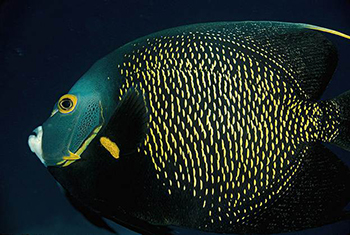French Angelfish
Pomacanthus paru

Kingdom: Animalia
Phylum: Chordata
Class: Actinopterygii
Order: Perciformes
Family: Pomacanthidae
Genus: Pomacanthus
Species: Pomacanthus paru
Common name: French Angelfish
Geographical Location: The French Angelfish is found in the Eastern Caribbean; North along the Florida coast and south Brazil. Depth range is 3-100m (Smith, 1997). French Angelfish are common in shallow with rocky bottoms that offer plenty of shelter. They are usually found in pairs and often near sea fans and sponges.
Length is up to 41 cm (Lieske and Myers, 1994).
Physical Characteristics: The French Angelfish has a thin, deep body with a small mouth and comb-like teeth. The adult form has a black body and the scales of the body are rimmed with golden yellow, except those at the front from nape to abdomen. The face is greyish black and the mouth is a greyish white. It has yellow rings around the eyes. The bases of the pectoral fins are yellow and it has one dorsal fin and one anal fin that trail back. The average adult length is 40cm. The juveniles differ from the adult form in body patterns. It has a black body with three thick yellow vertical bands. It also has a yellow band that extends down the forehead and around the mouth. The caudal fin is edged in yellow (Randall, 1996)
Longevity: Approximately 10-15 years.
Behavior and Reproduction: French Angelfish, because they are so thin, can turn quickly and maneuver down into narrow cracks between corrals giving them an advantage when they are being chased by predators or when they are hunting their prey. Angelfish use their pectoral fins for swimming and their long dorsal, anal, and caudal fin to turn quickly. Juvenile Angelfish set up cleaning stations. They wiggle their bodies in a fluttering motion to attract clients to the cleaning stations where they remove ectoparasites from a wide range of fish including jacks, snappers, moray, and grunts (Sazima et al., 1999). French Angelfish are very territorial. They join with their mate to defend vigorously a large territory from other angelfish. Angelfish reproduce by spawning which occurs from April through September and peaks in midsummer around July. Pairs swim several feet above the reef which involves a few short chases between the pair. If other angelfish get too close to the pair, they are quickly chased away (Moyer et al., 1983). The pair swims towards the surface slowly and bringing their vents close together, releases the eggs and sperm into the water. During each spawning event, they may release 25,000-75,000 eggs. The pelagic eggs hatch approximately 15-20 hours after fertilization. The larvae live among plankton until they reach about 15mm where upon they settle onto the coral reef.
Diet: French Angelfish main food is sponges, but they also feed on algae, byozoans, zooantharians, gorgonians, and tunicates. Juvenile angelfish; the majority of their diet consists of parasites picked from other fish bodies when cleaning them. French Angelfish will grow up to become relatively tough so only the largest reef predators such as sharks and groupers are likely to prey on them (Cervigón, 1993)
Ecology: French Angelfish are considered good quality for human consumption (Burgess, 1978). However there have been reports of ciguatera poisoning from eating them (Olsen et al., 1984). French Angelfish are also very popular among private aquarium owners due to its long lifespan and disease-resistant species
Endangerment and Conservation: Currently the French Angelfish is not considered an endangered species by the International Union for Conservation of Nature (IUCN).
Reference:
Please note that the following references may have either been removed or relocated by the webpage owners since the time this student report was created.
Cervigón, F. 1993. Los peces marinos de Venezuela. Volume 2. Fundación Científica Los Roques, Caracas,Venezuela. 497 p
Froese, Rainer, and Daniel Pauly, eds. (2006). "Pomacanthus paru" FishBase.org June 2006 version. 30 May 2012. http://www.fishbase.org/summary/Pomacanthus-paru.html
Lieske, E. and R. Myers 1994. Collins Pocket Guide. Coral reef fishes. Indo-Pacific & Caribbean including the Red Sea. Harper Collins Publishers, 400 p.
Moyer, J.T., R.E. Thresher and P.L. Colin. 1983. Courtship, spawning and inferred social organization of American angelfishes (genera Pomacanthus, Holacanthus and Centropyge: Pomacanthidae). Environ. Biol. Fish. 9(1):25-39.
Olsen, D.A., D.W. Nellis and R.S. Wood 1984. Ciguatera in the Eastern Caribbean. Mar. Fish. Rev. 46(1):13-18.
Randall, J.E. 1996 Caribbean reef fishes. Third edition - revised and enlarged. T.F.H. Publications, Inc. Ltd., Hong Kong. 3nd ed. 368 p.
Sazima, I., R.L. Moura and C. Sazima 1999 Cleaning activity of juvenile angelfish, Pomacanthus paru, on the reefs of the Abrolhos Archipelago, western South Atlantic. Environ. Biol. Fish. 56(4):399-407.
Smith, C.L. 1997 National Audubon Society field guide to tropical marine fishes of the Caribbean, the Gulf of Mexico, Florida, the Bahamas, and Bermuda. Alfred A. Knopf, Inc., New York. 720 p.
Ilyes, Laszlo. 200. “French Angelfish”. Photo. Flickr.com. 6 April 2000. 30 May 2012.< http://www.flickr.com/photos/40467171@N00/178797036>